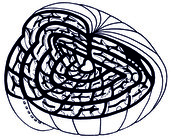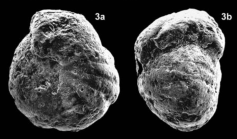Foraminifera taxon details
Rabanitina Smout, 1956 †
738421 (urn:lsid:marinespecies.org:taxname:738421)
accepted
Genus
Rabanitina basraensis Smout, 1956 † (type by original designation)
marine, brackish, fresh, terrestrial
fossil only
feminine
Smout, A. H. (1956). Three new Cretaceous genera of foraminifera related to the Ceratobuliminidae. <em>Micropaleontology.</em> 2(4): 335-345.
page(s): p. 343 [details] Available for editors [request]
[request]
page(s): p. 343 [details] Available for editors
Hayward, B.W.; Le Coze, F.; Vachard, D.; Gross, O. (2024). World Foraminifera Database. Rabanitina Smout, 1956 †. Accessed at: https://www.marinespecies.org/foraminifera/aphia.php?p=taxdetails&id=738421 on 2024-08-31
Date
action
by
original description
Smout, A. H. (1956). Three new Cretaceous genera of foraminifera related to the Ceratobuliminidae. <em>Micropaleontology.</em> 2(4): 335-345.
page(s): p. 343 [details] Available for editors [request]
[request]
page(s): p. 343 [details] Available for editors
From editor or global species database
Diagnosis Test subspherical, early stage trochospiral, planoconvex and umbilicate, then changing abruptly to a completely involute coil and becoming globular, a complex perforated plate within the adult chambers parallels the spiral wall but twists and is buttressed to both chamber floor and roof; wall imperforate, nonlamellar, microgranular, commonly altered in preservation, without arenaceous particles but probably originally agglutinated; aperture of the trochoid stage not observed, in the adult consists of a single or double row of pores near the base of the apertural face. U. Cretaceous (L. Cenomanian); Iraq. (Loeblich & Tappan, 1987, Foraminiferal Genera and Their Classification) [details]Diagnosis Test subspherical in the adult stage of growth, with a slight asymmetry of the poles. In the young stage of growth, it is trochoid with a flat top, a subacute margin, and a conical ventral surface with a slight ventral false umbilicus. The sutures are flush or slightly indented. The septa are nearly radial. In the adult chambers, and in all but the earliest juvenile ones, there is a complex longitudinal plate (endoskeleton) twisted with rows of large holes, substantially parallel to the spiral wall of the chamber. It is buttressed to floor and roof. The change from the trochoid to the globular habit is abrupt. The juvenile chambers are completely evolute dorsally, and the later ones are involute. The acute margin is gradually lost.
Taken and modified from the original description - Consorti (2022) pers. comm [details]

